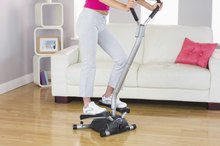What does fact checked mean?
At Healthfully, we strive to deliver objective content that is accurate and up-to-date. Our team periodically reviews articles in order to ensure content quality. The sources cited below consist of evidence from peer-reviewed journals, prominent medical organizations, academic associations, and government data.
The information contained on this site is for informational purposes only, and should not be used as a substitute for the advice of a professional health care provider. Please check with the appropriate physician regarding health questions and concerns. Although we strive to deliver accurate and up-to-date information, no guarantee to that effect is made.
Exercises to Slim Hips, Thighs & Stomach
No matter what your starting size or shape, you can lose fat and tone up, if you're willing to stick to a healthy diet rich in fruits, vegetables and lean meats, and put enough hours into your workouts. You need a combination of fat-burning cardio and muscle-building resistance exercises to transform your problem areas.
Cardio Is King, but Don't Forget to Stretch
Cardio exercise is one of the more effective methods for burning fat, so you can lose those layers of fat covering up the muscle underneath 2. You can't spot reduce from one specific area because fat is lost or gained throughout the body as a whole. Jumping rope, swimming, crossovers, twists and mountain climbers are a few ideas for cardio exercises to help you achieve a more toned appearance. Maintain proper form with each exercise, and fit in some stretching time after each workout. Stick to static stretches post-workout. These stretches relax your muscles by lengthening them, helping you cool down after a workout and preventing next-day muscle stiffness and soreness.
Slim Your Hips and Tone Your Thighs
How to Tighten Up the Thighs and Calves
Learn More
To work your hip muscles, try the barbell rear lunge, dumbbell squat, dumbbell lying hip abduction and step-up exercises 3. Your thighs are made up primarily of the quadriceps and hamstrings muscles 3. Lunges and squats work both muscle groups. Leg extensions strengthen the quads, while the standing leg curl targets the hamstrings.
Sculpt Your Stomach
The abdomen is made up of the rectus abdominis, the internal and external obliques, and the transverse abdominis muscles 3. Include crunches, side bends and "push sit-ups" as part of your workout routine for these muscles.
Related Articles
References
Writer Bio
Michelle Dawn has written professionally since 2005, covering a variety of topics over that time, the majority of that work focused on health and well-being. A Registered Holistic Nutritionist and Certified Yoga Instructor, she enjoys teaching others how to live their healthiest, happiest life.









